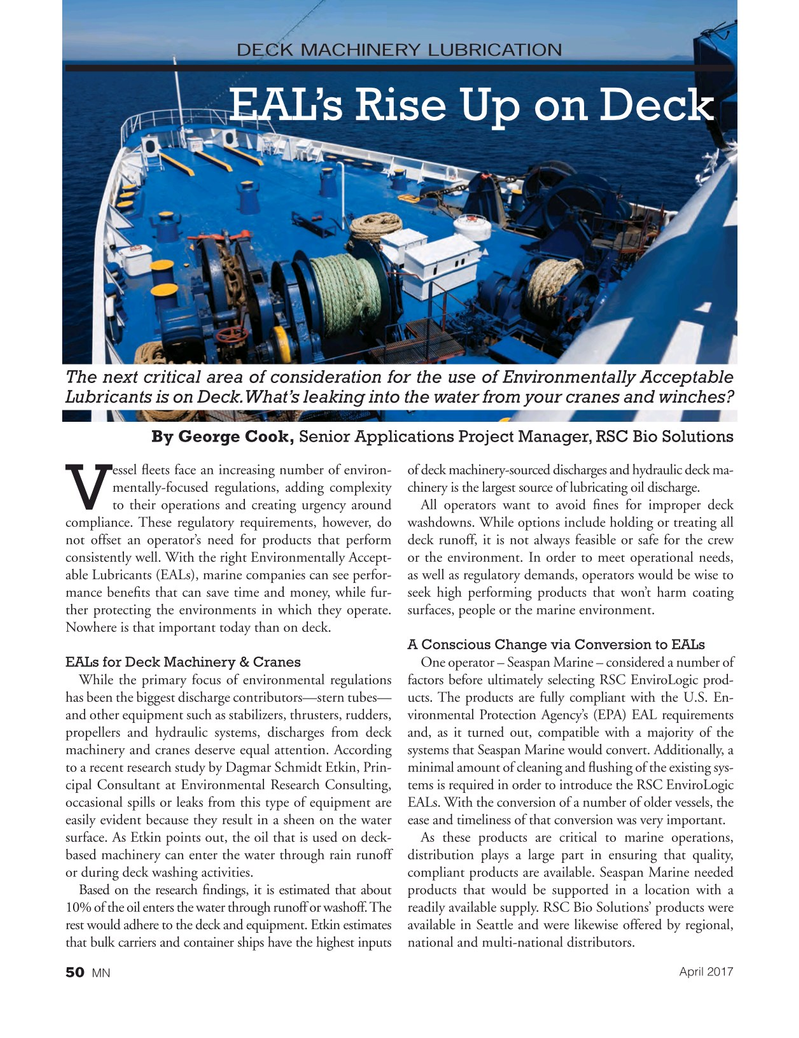
Page 50: of Marine News Magazine (April 2017)
Boatbuilding: Construction & Repair
Read this page in Pdf, Flash or Html5 edition of April 2017 Marine News Magazine
DECK MACHINERY LUBRICATION
EAL’s Rise Up on Deck
The next critical area of consideration for the use of Environmentally Acceptable
Lubricants is on Deck. What’s leaking into the water from your cranes and winches?
By George Cook, Senior Applications Project Manager, RSC Bio Solutions essel ? eets face an increasing number of environ- of deck machinery-sourced discharges and hydraulic deck ma- mentally-focused regulations, adding complexity chinery is the largest source of lubricating oil discharge.
Vto their operations and creating urgency around All operators want to avoid ? nes for improper deck compliance. These regulatory requirements, however, do washdowns. While options include holding or treating all not offset an operator’s need for products that perform deck runoff, it is not always feasible or safe for the crew consistently well. With the right Environmentally Accept- or the environment. In order to meet operational needs, able Lubricants (EALs), marine companies can see perfor- as well as regulatory demands, operators would be wise to mance bene? ts that can save time and money, while fur- seek high performing products that won’t harm coating ther protecting the environments in which they operate. surfaces, people or the marine environment.
Nowhere is that important today than on deck.
A Conscious Change via Conversion to EALs
EALs for Deck Machinery & Cranes One operator – Seaspan Marine – considered a number of
While the primary focus of environmental regulations factors before ultimately selecting RSC EnviroLogic prod- has been the biggest discharge contributors—stern tubes— ucts. The products are fully compliant with the U.S. En- and other equipment such as stabilizers, thrusters, rudders, vironmental Protection Agency’s (EPA) EAL requirements propellers and hydraulic systems, discharges from deck and, as it turned out, compatible with a majority of the machinery and cranes deserve equal attention. According systems that Seaspan Marine would convert. Additionally, a to a recent research study by Dagmar Schmidt Etkin, Prin- minimal amount of cleaning and ? ushing of the existing sys- cipal Consultant at Environmental Research Consulting, tems is required in order to introduce the RSC EnviroLogic occasional spills or leaks from this type of equipment are EALs. With the conversion of a number of older vessels, the easily evident because they result in a sheen on the water ease and timeliness of that conversion was very important.
surface. As Etkin points out, the oil that is used on deck- As these products are critical to marine operations, based machinery can enter the water through rain runoff distribution plays a large part in ensuring that quality, or during deck washing activities. compliant products are available. Seaspan Marine needed
Based on the research ? ndings, it is estimated that about products that would be supported in a location with a 10% of the oil enters the water through runoff or washoff. The readily available supply. RSC Bio Solutions’ products were rest would adhere to the deck and equipment. Etkin estimates available in Seattle and were likewise offered by regional, that bulk carriers and container ships have the highest inputs national and multi-national distributors.
April 2017
MN 50

 49
49

 51
51
